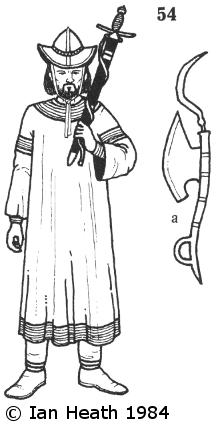Try Amazon Audible Premium Plus and Get Up to Two Free Audiobooks

Register a SNAP EBT card with Amazon
VARANGIAN GUARDSMAN, 14th CENTURY
An extract from Armies of the Middle Ages, Volume 2
by Ian Heath
[Based on Byzantine Emperor John VI Kantakouzenos presiding over a synod, The Hesychast Council of Constantinople, 1351.]

54. VARANGIAN GUARDSMAN, 14th CENTURY
This figure is based chiefly on the last known contemporary picture of a Varangian,
a ms. illustration of c.1370-75 depicting John VI Cantacuzene (1341-54) at an ecumenical council of 1351,
surrounded by his guardsmen, of whom 8 are visible.
In his own ‘Historiae’ Cantacuzene wrote of ‘Varangians with their axes’ under the years 1316, 1328, 1330 and 1341,
and though he wrote after 1354 it would seem that Varangians with axes were still well-enough known to require no further explanation.
However, they appear to have performed only palace and ceremonial duties by the mid-14th century (see page 18).
This figure appropriately enough wears court dress, composed of a blue uniform, probably with gold embroidery,
and a boat-shaped white hat with gold trim that was typical of 14th-15th century court functionaries.
Some details, such as the knotted gold cord chinstrap, are added from 15th-16th century Greek icons.
On his shoulder he carries the Emperor’s black-and-gold hilted sword in a red scabbard.
54a is from a Palaeologian-period seal of the Grand Interpreter of the Varangians.
Despite its somewhat unorthodox shape, Sigfus Blondal claims that this is the axe of a Varangian; other authorities, however, consider it to be the symbol of a lictor.
Next: 55. BYZANTINE CAVALRYMAN 1439, in Armies of the Middle Ages, Volume 2 by Ian Heath


